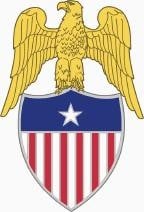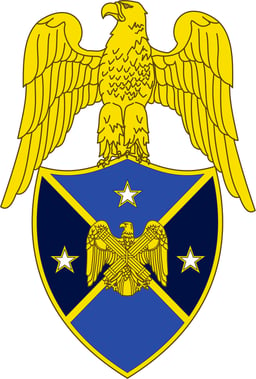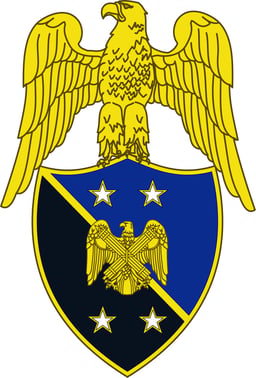Aide-de-camp
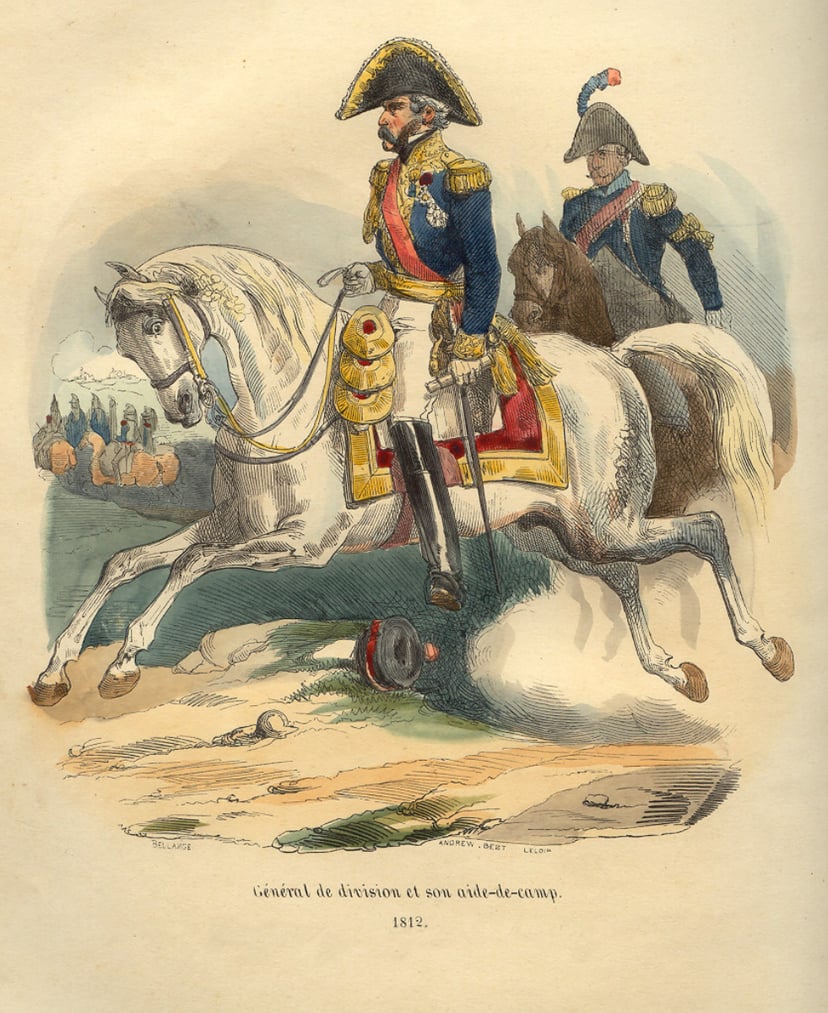
Aide-de-camp
An aide-de-camp may participate at ceremonial functions, and the first aide-de-camp is typically the foremost personal aide. This is not to be confused with an adjutant, who is the senior administrator of a military unit.
The badge of office for an aide-de-camp is usually the aiguillette, a braided cord in gold or other colours, worn on the shoulder of a uniform. Whether it is worn on the left or the right shoulder is dictated by protocol.
In some countries, aide-de-camp is considered to be a title of honour, which confers the post-nominal letters ADC or A de C.
Argentina
In Argentina, three officers (one from each armed service, of the rank of lieutenant colonel or its equivalent), are appointed as aide-de-camp to the president of the republic and three others to the minister of defense, these six being the only ones to be called "edecán", which is one Spanish translation for aide-de-camp ("ayudante de campo" is another – "edecán" is a phonetic imitation of the French term; "ayudante de campo" is a word-for-word translation of it).
A controversy was raised in 2006, when president Néstor Kirchner decided to promote his army aide-de-camp, Lieutenant Colonel Graham to colonel, one year ahead of his class. Upon taking office, former president Cristina Kirchner decided to have, for the first time, female officers as her aides-de-camp.
In each of the armed forces, the chief of staff and other senior officers have their own adjutants, normally of the rank of major or lieutenant colonel, or its equivalent. At unit level, the unit S-1 (personnel officer) doubles as the unit commander's adjutant, although in recent times in many units this practice has been left only for ceremonial purposes, while for everyday duties a senior NCO performs the adjutant's activities.
An aiguillette is worn on the right shoulder by aides-de-camp and adjutants as a symbol of their position, the colour of the aiguillette depending of the rank of the person they are serving (there are golden, tan, silver and red aiguillettes, as well as an olive-green one for combat uniform).
Belgium
In Belgium the title of honorary aide-de-camp to the King can be granted by the royal court for services rendered. Notable people include Major General Baron Édouard Empain, Count Charles John d'Oultremont, and Lieutenant General Baron Albert du Roy de Blicquy.
Commonwealth of Nations countries
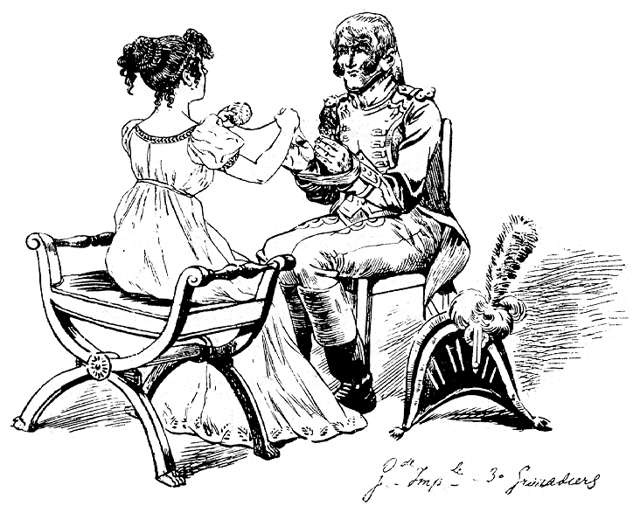
Her Aide-de-Camp, early 19th-century humorous/symbolic drawing
An aide-de-camp, according to an 1816 military dictionary, was defined as an officer appointed to attend a general officer, and was traditionally seldom under the grade of captain: "The King may appoint for himself as many as he pleases, which appointment gives the rank of colonel in the army. Generals being field marshals, have four, lieutenant generals two, major generals one".[2]
In British colonies and modern-day British overseas territories, an aide-de-camp is appointed to serve the governor and, later, the governor general. These aides were mostly from military branches or native auxiliaries. They were entitled to use letters ADC or A de C after their names.[3] The emblem of the office is the aiguillette worn on their uniform.
Australia
Australian Defence Force officers serve as aides-de-camp to specific senior appointments, such as the Queen, Governor-General, state governors, Chief of the Defence Force, and other specified Army, Navy and Air Force command appointments. Honorary aides-de-camp to the Governor-General or state governors are entitled to the post-nominal ADC during their appointment. Officers of and above the ranks of rear admiral, major general, and air vice marshal in specifically designated command appointments are entitled to an aide de camp with the army rank of captain (or equivalent). Within the navy, an aide-de-camp is called a "flag lieutenant" (as senior naval officers are "flag officers").
Bermuda
In 1973, the Governor of Bermuda, Sir Richard Sharples, and his aide-de-camp, Captain Hugh Sayers, were murdered on the grounds of Government House.
Canada

Aide-de-camp Colonel Jean-Claude Cloutier with then–Quebec Lieutenant-Governor Lise Thibault.
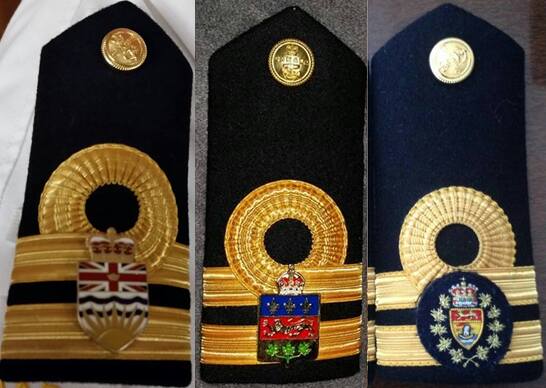
Royal Canadian Navy shoulder boards worn by honorary aides-de-camp to the lieutenant governors of British Columbia (left) Québec (centre) and New Brunswick (right)
Aides-de-camp in Canada are appointed to the Queen and some members of the royal family, the governor general, lieutenant governors, and to certain other appointments (e.g., Minister of National Defence, flag and general officers, Canadian heads of mission, foreign heads of state visiting Canada).[4]
In addition to the military officers appointed as full-time aides-de-camp to the governor general, several other flag/general and senior officers are appointed ex officio as honorary aides-de-camp to the governor general or Members of the Royal Family including:[4]
The Chief of the Defence Staff
The commandant of the Royal Military College of Canada
A senior officer of the Quebec-based Royal 22e Régiment
Commanding officer, The Governor General's Horse Guards
Commanding officer, Governor General's Foot Guards
Commanding officer, The Canadian Grenadier Guards
Commanding officer, The Queen's Own Rifles of Canada
The commanding officers of Naval Reserve divisions
Most aides-de-camp wear a gold pattern aiguillette when acting in their official capacity; however, members of St. John Ambulance Canada wear silver aiguillettes consistent with their other accoutrements as aide-de-camp or as a symbol of ceremonial representation such as a member of the honour guard or a position of command on parade. All aides-de-camp also wear the cypher or badge of the principal to whom they are appointed.[5] Honorary appointees to the Queen (royal cypher), to the Duke of Edinburgh, or the Prince of Wales, wear the appropriate cypher on their uniform epaulette and are entitled to use the post-nominal letters ADC for the duration of their appointment.
Aides-de-camp to the governor general wear the governor general's badge (crest of the arms of Canada) and aides-de-camp to a lieutenant governor wear the lieutenant governor's badge (the shield of the province surmounted by a crown).[5] They are appointed from officers of the Canadian Forces. Aides-de-camp to lieutenant governors are appointed from officers of the Canadian Forces, Royal Canadian Mounted Police and, depending on the province, aides may also be appointed from other uniformed organizations such as municipal or provincial police and emergency services. In certain instances, civilians may be appointed. Non-uniformed civilians do not wear the aiguillette, but do wear their lieutenant governor's badge as a symbol of their appointment. On 29 November 1973, Governor General Roland Michener concluded his initiative to permit aides-de-camp to the governor general and lieutenant governors to use the post-nominal letters A de C for the duration of their appointment.[3][6]
Aides-de-camp to royal and vice-regal personages wear the aiguillette on the right shoulder. Aides-de-camp to all others wear their aiguillette on the left shoulder.[5]
India
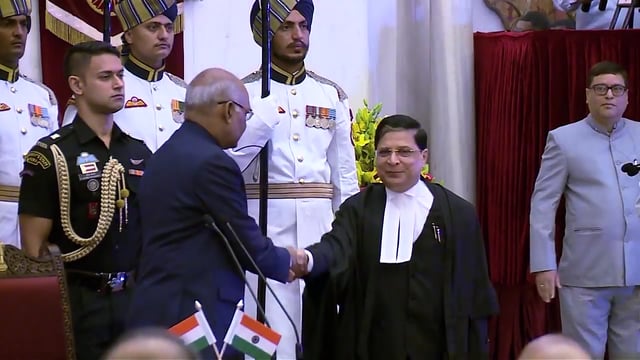
A presidential aide-de-camp can be seen to the left of President Ram Nath Kovind, who has just administered the oath of office to Indian chief justice Dipak Misra on 28 August 2017.
In India, officers of the rank of major general and equivalent and above in the sister services who are in command of divisions or of peacetime commands have aides-de-camp who usually belong to their general's parent regiment/battalion. There have been instances where the sons have served a tenure of aide-de-camp to their fathers. The service chiefs (Chief of the Army/Air/Navy Staff) usually have three aides-de-camp and the President of India has five aides-de-camp (three from the army and one each from the navy and the air force). There is also one honorary aide-de-camp from the Territorial Army.The president may at his pleasure appoint any distinguished officer from the armed forces including the service chiefs as honorary aide-de-camp. The governors of the states have two aides-de-camp, one each from the Indian armed forces and the Indian and state police services except for the state of Jammu and Kashmir where both the aides-de-camp to the governor are appointed from the Indian Army.
New Zealand
As in other Commonwealth countries where the Queen is head of state, personnel from the New Zealand Defence Force serve as aides-de-camp to royal and vice-regal personages. The governor-general of New Zealand has two full-time aides-de-camp of the rank of army captain, lieutenant RNZN or RNZAF flight lieutenant. Additional and honorary aides-de-camp to the governor-general are of the rank of lieutenant colonel or equivalent. Aiguilettes are of the standard palace No. 1 type and worn on the right shoulder. Equivalent appointments also serve the minister of Defence, the chief of Defence Force and service chiefs. These are usually known as military assistants (MA) personal staff officers (PSOs) or, in the case of the RNZN, flag lieutenant (flags), and wear service-specific No. 2 aigullettes with coloured flecks (dark blue for navy, red for army and light blue for air force) on the left shoulder.
Pakistan
In Pakistan the President, Prime Minister and Governors have their own aides-de-camp. The aide-de-camp can be from any one of the three Armed Forces and typically are of the rank of captain (army), lieutenant (navy) or flight lieutenant (air force). The aide-de-camp to Justice Khan Habibullah Khan, while he was chief minister and leader of the house of West Pakistan, was his son, a senior bureaucrat, Captain Akhtar Munir Marwat and Captain Gohar Ayub Khan was to his father, President Field Marshal Ayub Khan. The Chairman of the Joint Chiefs of Staff Committee and all the three service chiefs are authorised to have an aide-de-camp. In Pakistan, officers of the rank of major general and equivalent and above in the sister services who are in command of divisions or of peacetime commands have aides-de-camp who usually belong to their general's parent regiment/battalion.
Papua New Guinea
As in other commonwealth realms where the Queen is head of state, the governor-general of Papua New Guinea has two full-time aides-de-camp. One is from the Papua New Guinea Defence Force and one from the Royal Papua New Guinea Constabulary of the ranks of PNGDF Captain and RPNGC Superintendent.[7]
Singapore
In Singapore, the President appoints aides-de-camp from the armed services as well as officers selected from the police force and civil defence force. These officers usually hold the rank of major or military expert 5 in the armed services or major in the Singapore civil defence force, whereas an assistant superintendent of police is chosen from the Singapore police force. Both male and female officers may serve as aides-de-camp.
Their duties include assisting in liaison for important guests on behalf of the president and taking care of visiting foreign dignitaries.[8]
Sri Lanka
In Sri Lanka, the president has aides-de-camp from the three armed services as well as extra aides-de-camp. All general, flag and air officers have their own aide-de-camp, usually selected from their parent regiment or unit. In the navy, an aide-de-camp is called a flag lieutenant. Junior officers of the rank of major and below serve as aide-de-camp, appointed only if they have completed three years of commissioned service. Officers appointed as an aide-de-camp or extra aide-de-camp can serve a maximum of three years, with the exception of those serving the president. Once an officer completes a term of service as an aide-de-camp or extra aide-de-camp, the officer can not be reappointed to a similar position for another two years. Medical officers of the rank of lieutenant colonel and above can be appointed as Honorary Physician to the President or Honorary Surgeon to the President.[9]
Twice in 1992, Sri Lankan aides-de-camp were killed in service, and in 2006 an aide-de-camp was seriously injured:
On 8 August 1992, Major General Denzil Kobbekaduwa (Overall Operations Commander - Northern Sector) and his aide-de-camp Major Nalin S. De Alwis, were killed along with several senior army and navy officers when their Land Rover hit a land mine off Araly Point in Kayts.[10]
On 16 November 1992 the Commander of the Sri Lanka Navy, Rear Admiral Clancy Fernando and his flag lieutenant, Lieutenant Sandun Gunasekera, were assassinated by a LTTE suicide bomber who drove an explosives laden motorbike into the admiral's staff car in front of the Galle Face Green.[11]
In 2006 the Commander of the Sri Lanka Army, Lieutenant General Sarath Fonseka, and his aide-de-camp Major Priyal Wickramasinghe were seriously wounded in a LTTE suicide bomb attack by a pregnant LTTE operative on the general's staff car inside Army Headquarters.[12][13][14]
Tanzania
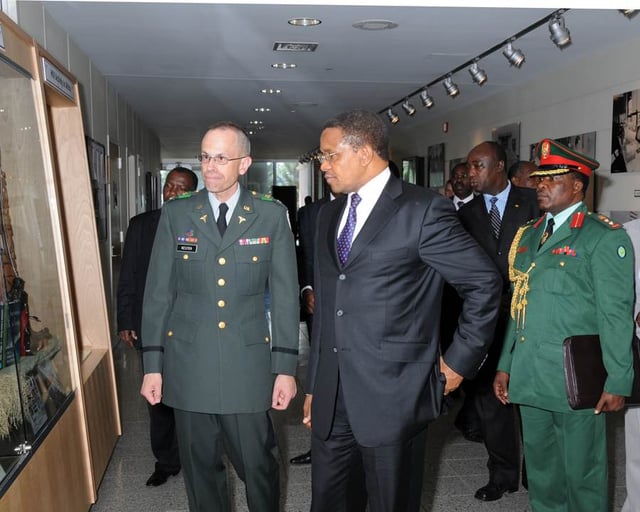
Dr. Jakaya Kikwete, President of Tanzania, with his aide-de-camp (right) in 2009
The President of Tanzania has an aide-de-camp from the Tanzania People's Defence Force, with the rank of Kanali (colonel).
United Kingdom

General Sir Baker Russell wearing the full-dress uniform of an aide-de-camp to Queen Victoria
In the United Kingdom, junior officers serve as aides-de-camp to certain senior officers. Flag lieutenant is the Royal Navy's equivalent. Equerries are equivalents to aides-de-camp in the Royal Household, in which aides-de-camp are restricted to senior officers with a primarily honorific role.
There are several categories of these senior aides-de-camp to the Queen, which entitle the aide-de-camp to the post-nominal letters "ADC". Most are serving army, navy, and air force officers, usually of colonel or brigadier rank or equivalent. There are also specific posts for very senior officers, such as first and principal naval aide-de-camp, flag aide-de-camp, aides de camp general, and air aides-de-camp. Analogous offices include the Lieutenant of the Admiralty, the Rear Admiral of the United Kingdom, and the Gold Stick and Silver Stick.
Certain members of the Royal Family with military rank may be appointed personal aides-de-camp to the Queen. Those currently holding this appointment are HRH The Duke of Kent; HRH The Prince of Wales; HRH The Duke of Cambridge; HRH The Duke of York; HRH The Earl of Wessex; HRH The Duke of Sussex and Vice Admiral Sir Timothy Laurence. In addition, when wearing a military uniform, HRH The Duke of Edinburgh wears the insignia of a personal aide-de-camp to the Queen's father, King George VI.
Aides-de-camp and equerries (along with certain other officers) are distinguished by the addition of aiguillettes to dress uniforms, which differ in size, colour and position of wear, depending on the appointment. In addition, aides-de-camp to the monarch wear the monarch's royal cypher on their shoulder straps in various orders of dress. A distinctive and elaborate full dress uniform used to be worn by army aides-de-camp, but its use was largely discontinued after World War I.
France
The President, as commander-in-chief of the French armed forces, is served by aides-de-camp. In general, there are three, including one who traditionally serves in the French Army, and all of whom are at the rank of lieutenant colonel. In essence, their mission is to transport the briefcase permitting the use of nuclear weapons. They can also provide general assistance to the President: For instance, at times aides-de-camp are seen placing the president's speech on his lectern when he arrives, or holding up notes during award ceremonies to remind him of the official words to be pronounced when handing over medals.
When the president travels, an aide-de-camp often rides in the front passenger seat of the presidential car. He is one of the people who are closest to the president.
Hong Kong
The Hong Kong Police Force, the Fire Services Department, the Customs and Excise Department, the Immigration Department, the Government Flying Service, the Civil Aid Service, the Hong Kong Auxiliary Police Force, the Auxiliary Medical Service, the St. John Ambulance Brigade, and the Correctional Services Department each sends an aide-de-camp to the territory's chief executive, which replaced the governor in 1997.
On the last day of British rule in Hong Kong on 30 June 1997, the police aide-de-camp to Governor Chris Patten, presented Patten with the flag at Government House. He then gave the Vice Regal Salute before proceeding, with the Pattens, to leave Government House for the last time.
Imperial Russia
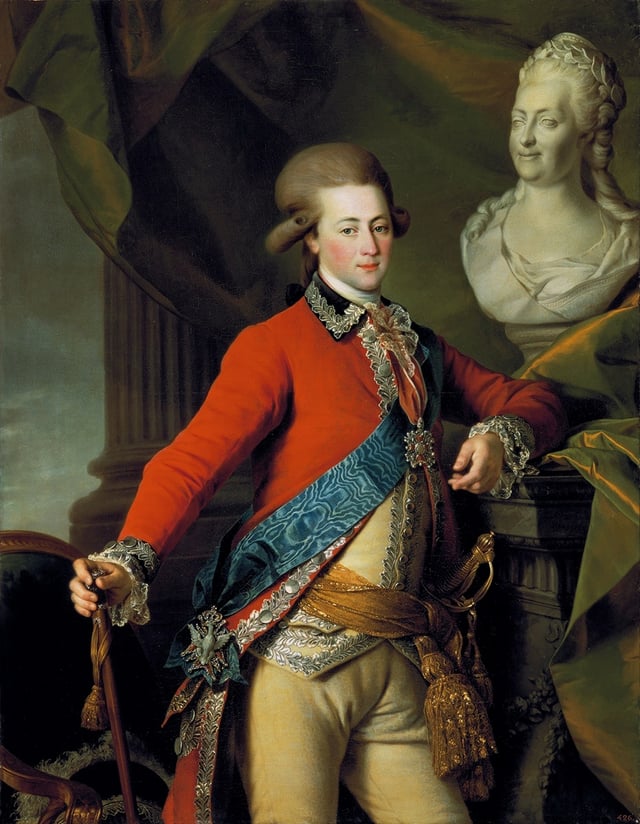
Portrait of Alexander Lanskoy, aide-de-camp to the Empress, 1782, Russia
In the 18th-Century, under Catherine the Great of Russia, favorites of the Empress were frequently appointed as her aides-de-camp.
Japan
From 1896 until the end of World War II, the Emperors of Japan had army and naval aides-de-camp.
Thailand
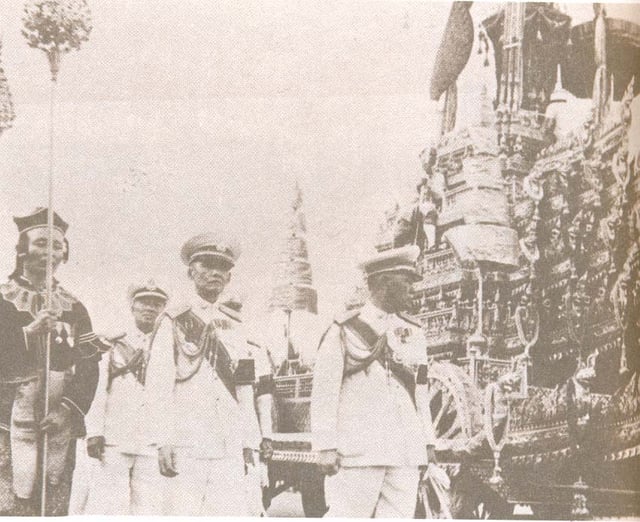
Royal aide-de-camp (center) in the ceremonial progress for the royal funeral of King Ananda Mahidol
Royal Thai Aide-De-Camp Department is a royal service agency under the Royal Security Command. It is responsible for organizing royal appearances and maintaining the safety of the Thai Royal Family. Royal Thai aide-de-camps are also appointed to senior officers of the Thai army, navy, and air force. King Chulalongkorn initiated the Royal Guard in 1870, during his visit to Singapore and Indonesia. He had Lieutenant General Prince Suksvasti serve as his aide, and Prince Suksvasti is considered the first Thai aide-de-camp.[15]
United States
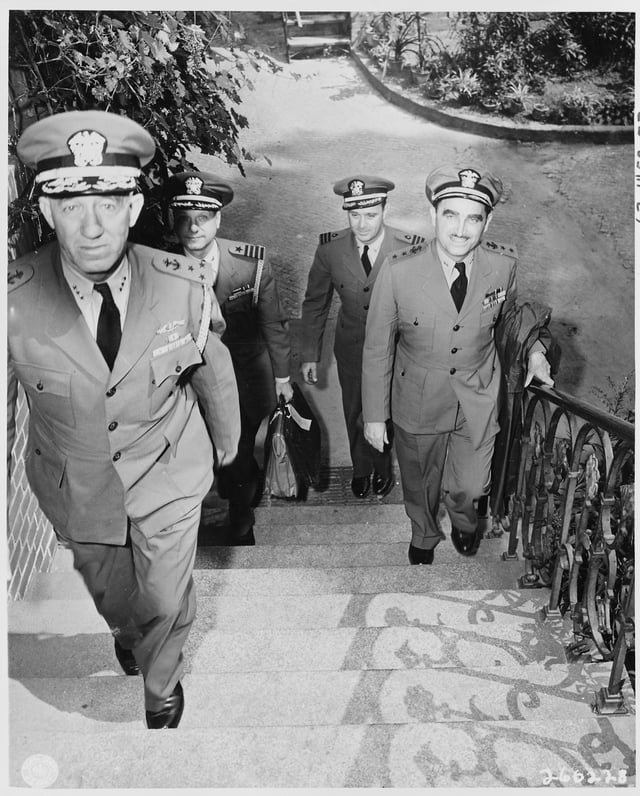
US Captain A. S. McDill (left rear), aide-de-camp to Fleet Admiral Ernest J. King, COMINCH.

Aide de Camp holds a brigadier general's flag as the general unfurls it
Military officers are assigned as aides to the Secretary of the Army, Secretary of Defense, Vice President, and President of the United States. For government officials with more than one aide, the senior-ranking aide usually coordinates the activities of the other aides as well as personal attendants such as drivers or orderlies.
The President has five military aides, one from each of the armed services. The President's aides from the Army, Marine Corps and Air Force are majors or lieutenant colonels, and the aides from the Navy and Coast Guard are lieutenant commanders or commanders. One of their major roles is to hold the Presidential emergency satchel. In addition to the five permanent aides-de-camp, there are some 40–45 military social aides holding more junior ranks from lieutenant to major. Their appointment is temporary and part-time, serving for perhaps two to four afternoons a month as required, for social purposes such as gatherings hosted at the White House.
Within the United States Army, aides-de-camp are specifically appointed to General-grade officers (NATO Code OF-6 through OF-10). The usual tour of duty for aides is up to two years. Although Congress has authorized general officers to be assigned up to three officer aides, their number and rank being contingent upon the general's grade, Army regulations have traditionally limited each general to a single officer aide.[16][17] Some generals are also authorized to have enlisted aides on their staff.[18] A general, based on his or her grade, may choose for an aide-de-camp any commissioned officer up to the following maximum rank:[16]
- Brigadier general:LieutenantMajor general:CaptainLieutenant General:MajorGeneral:Lieutenant ColonelGeneral of the Army: Lieutenant Colonel, and 3 authorized enlisted aides[17]Chief of Staff, U.S. Army: Lieutenant Colonel, and 4 authorized enlisted aides[19]
Lieutenant colonels and colonels in command of units (battalions and brigades, respectively) do not have aides. Occasionally, the unit's adjutant (S-1) will assist the commanding officer as an aide, but this is uncommon. A General of the Army does not retire and remains an officer of the United States Army for life, entitled to an aide of the rank of Colonel.
U.S. Army aides-de-camp wear a special device in place of the branch-of-service insignia (e.g., infantry, artillery, quartermaster) that they would otherwise wear on the lapels of their service uniform. The rank of the General Officer being served is indicated on the device worn by the aide-de-camp, as illustrated below. Although the Chief of Staff of the Army and the Chairman of the Joint Chiefs of Staff are O-10 positions, their aides-de-camp wear devices specific to those offices, rather than the normal four-star aide device. Also, an aide-de-camp wears a special aiguillette on the shoulder of his or her dress uniform.
In the United States Navy, the aide-de-camp to an admiral is also known as a "flag aide" (command ashore) or "flag lieutenant" (command afloat).[20][21]
Variations
Air aide-de-camp
First and principal naval aide-de-camp
Flag aide-de-camp
Naval aide-de-camp
Aide-de-camp general
Galloper (obsolete)
Aide-de-camp to the Emperor of Japan
Aide-de-camp extraordinary
Executive aide-de-camp
General's enlisted aide
See also
Batman (military), a similar role for lesser officers
Body man, for modern politicians
